Breed Varieties of Pigs for Disease Resistance and Susceptibility to Seneca Valley Virus Infection
Abstract
1. Introduction
2. Results
2.1. Production Performance and Survival Rate
2.2. SVV RNA Copies Number in Two Piglet Breeds
2.3. Intestinal Mucosal-Specific IgA and IgG
2.4. Min Pigs Inhibit SVV Infection with Immunofluorescence Analysis
2.5. Activated Macrophage Inhibiting SVV in Min Pigs
2.6. M1 Polarization from Min Pigs Against SVV Infection
2.7. Induction of M1 Polarization Associated with SVV Is Mediated Through the Activation of IFN-λ and IL-6
3. Discussion
4. Materials and Methods
4.1. Ethics Statement
4.2. Cell Line and Virus
4.3. Experimental Infection and Experimental Design
4.4. qRT-PCR Analysis
4.5. Histopathology and IFA Assessment
4.6. The Production of Specific SVV Antibodies
4.7. Flow Cytometry
4.8. Western Blot
4.9. Statistical Analysis
5. Conclusions
Author Contributions
Funding
Institutional Review Board Statement
Informed Consent Statement
Data Availability Statement
Acknowledgments
Conflicts of Interest
References
- China Committee on Animal Genetic Resources. Animal Gentic Resources in China; China Agriculture Press: Beijing, China, 2011; Volume 7, p. 26. [Google Scholar]
- Meng, C.; Su, L.; Li, Y.; Zhu, Q.; Li, J.; Wang, H.; He, Q.; Wang, C.; Wang, W.; Cao, S. Different susceptibility to porcine reproductive and respiratory syndrome virus infection among Chinese native pig breeds. Arch. Virol. 2018, 163, 2155–2164. [Google Scholar] [CrossRef]
- Li, J.; Chen, Z.; Zhao, J.; Fang, L.; Fang, R.; Xiao, J.; Chen, X.; Zhou, A.; Zhang, Y.; Ren, L.; et al. Difference in microRNA expression and editing profile of lung tissues from different pig breeds related to immune responses to HP-PRRSV. Sci. Rep. 2015, 5, 9549. [Google Scholar] [CrossRef] [PubMed]
- Jiang, C.; Xing, F.; Xing, J.; Jiang, Y.; Zhou, E. Different expression patterns of PRRSV mediator genes in the lung tissues of PRRSV resistant and susceptible pigs. Dev. Comp. Immunol. 2013, 39, 127–131. [Google Scholar] [CrossRef] [PubMed]
- Yang, F.; Zhu, Z.; Cao, W.; Liu, H.; Zhang, K.; Tian, H.; Liu, X.; Zheng, H. Immunogenicity and protective efficacy of an inactivated cell culture-derived Seneca Valley virus vaccine in pigs. Vaccine 2018, 36, 841–846. [Google Scholar] [CrossRef] [PubMed]
- Ait-Ali, T.; Wilson, A.D.; Westcott, D.G.; Clapperton, M.; Waterfall, M.; Mellencamp, M.A.; Drew, T.W.; Bishop, S.C.; Archibald, A.L. Innate immune responses to replication of porcine reproductive and respiratory syndrome virus in isolated Swine alveolar macrophages. Viral Immunol. 2007, 20, 105–118. [Google Scholar] [CrossRef]
- Liu, H.; Zhu, Z.; Xue, Q.; Yang, F.; Cao, W.; Xue, Z.; Liu, X.; Zheng, H. Picornavirus infection enhances aspartate by the SLC38A8 transporter to promote viral replication. PLoS Pathog. 2023, 19, e1011126. [Google Scholar]
- Xing, J.H.; Niu, T.M.; Zou, B.S.; Yang, G.L.; Shi, C.W.; Yan, Q.S.; Sun, M.J.; Yu, T.; Zhang, S.M.; Feng, X.Z.; et al. Gut microbiota-derived LCA mediates the protective effect of PEDV infection in piglets. Microbiome 2024, 12, 20. [Google Scholar] [CrossRef]
- Vannucci, F.A.; Linhares, D.C.; Barcellos, D.E.; Lam, H.C.; Collins, J.; Marthaler, D. Identification and Complete Genome of Seneca Valley Virus in Vesicular Fluid and Sera of Pigs Affected with Idiopathic Vesicular Disease, Brazil. Transbound. Emerg. Dis. 2015, 62, 589–593. [Google Scholar] [CrossRef]
- Baker, K.L.; Mowrer, C.; Canon, A.; Linhares, D.C.; Rademacher, C.; Karriker, L.A.; Holtkamp, D.J. Systematic Epidemiological Investigations of Cases of Senecavirus A in US Swine Breeding Herds. Transbound. Emerg. Dis. 2017, 64, 11–18. [Google Scholar] [CrossRef]
- Gimenez-Lirola, L.G.; Rademacher, C.; Linhares, D.; Harmon, K.; Rotolo, M.; Sun, Y.; Baum, D.H.; Zimmerman, J.; Pineyro, P. Serological and Molecular Detection of Senecavirus A Associated with an Outbreak of Swine Idiopathic Vesicular Disease and Neonatal Mortality. J. Clin. Microbiol. 2016, 54, 2082–2089. [Google Scholar] [CrossRef]
- Yang, M.; van Bruggen, R.; Xu, W. Generation and diagnostic application of monoclonal antibodies against Seneca Valley virus. J. Vet. Diagn. Investig. 2012, 24, 42–50. [Google Scholar]
- Cao, L.; Zhang, R.; Liu, T.; Sun, Z.; Hu, M.; Sun, Y.; Cheng, L.; Guo, Y.; Fu, S.; Hu, J.; et al. Seneca Valley virus attachment and uncoating mediated by its receptor anthrax toxin receptor 1. Proc. Natl. Acad. Sci. USA 2018, 115, 13087–13092. [Google Scholar] [CrossRef]
- Takenouchi, T.; Masujin, K.; Ikeda, R.; Haraguchi, S.; Suzuki, S.; Uenishi, H.; Onda, E.; Kokuho, T. Establishment and characterization of an immortalized red river hog blood-derived macrophage cell line. Front. Immunol. 2024, 15, 1465952. [Google Scholar] [CrossRef]
- Kim, H.M.; Lee, Y.W.; Lee, K.J.; Kim, H.S.; Cho, S.W.; van Rooijen, N.; Guan, Y.; Seo, S.H. Alveolar macrophages are indispensable for controlling influenza viruses in lungs of pigs. J. Virol. 2008, 82, 4265–4274. [Google Scholar] [CrossRef]
- Schäfer, A.; Franzoni, G.; Netherton, C.L.; Hartmann, L.; Blome, S.; Blohm, U. Adaptive Cellular Immunity against African Swine Fever Virus Infections. Pathogens 2022, 11, 274. [Google Scholar] [CrossRef] [PubMed]
- Kapetanovic, R.; Fairbairn, L.; Downing, A.; Beraldi, D.; Sester, D.P.; Freeman, T.C.; Tuggle, C.K.; Archibald, A.L.; Hume, D.A. The impact of breed and tissue compartment on the response of pig macrophages to lipopolysaccharide. BMC Genom. 2013, 14, 581. [Google Scholar] [CrossRef] [PubMed]
- Liao, F.; Tang, Y.D.; Tan, L.; Yao, J.; Zheng, C.; Wang, A. Using the CRISPR-Cas System to Solve Porcine Viral Infection-related Issues. Crispr. J. 2021, 4, 776–788. [Google Scholar] [PubMed]
- Badaoui, B.; Grande, R.; Calza, S.; Cecere, M.; Luini, M.; Stella, A.; Botti, S. Impact of genetic variation and geographic distribution of porcine reproductive and respiratory syndrome virus on infectivity and pig growth. BMC Vet. Res. 2013, 9, 58. [Google Scholar]
- Islam, M.A.; Neuhoff, C.; Aqter Rony, S.; Große-Brinkhaus, C.; Uddin, M.J.; Hölker, M.; Tesfaye, D.; Tholen, E.; Schellander, K.; Pröll-Cornelissen, M.J. PBMCs transcriptome profiles identified breed-specific transcriptome signatures for PRRSV vaccination in German Landrace and Pietrain pigs. PLoS ONE 2019, 14, e0222513. [Google Scholar]
- Zhao, J.; Zhu, L.; Xu, L.; Huang, J.; Sun, X.; Xu, Z. Porcine interferon lambda 3 (IFN-lambda3) shows potent anti-PRRSV activity in primary porcine alveolar macrophages (PAMs). BMC Vet. Res. 2020, 16, 408. [Google Scholar]
- Magoro, T.; Dandekar, A.; Jennelle, L.T.; Bajaj, R.; Lipkowitz, G.; Angelucci, A.R.; Bessong, P.O.; Hahn, Y.S. IL-1beta/TNF-alpha/IL-6 inflammatory cytokines promote STAT1-dependent induction of CH25H in Zika virus-infected human macrophages. J. Biol. Chem. 2019, 294, 14591–14602. [Google Scholar] [CrossRef]
- Carta, T.; Razzuoli, E.; Fruscione, F.; Zinellu, S.; Meloni, D.; Anfossi, A.; Chessa, B.; Dei Giudici, S.; Graham, S.P.; Oggiano, A.; et al. Comparative Phenotypic and Functional Analyses of the Effects of IL-10 or TGF-beta on Porcine Macrophages. Animals 2021, 11, 1098. [Google Scholar] [CrossRef] [PubMed]
- Zdrenghea, M.T.; Makrinioti, H.; Muresan, A.; Johnston, S.L.; Stanciu, L.A. The role of macrophage IL-10/innate IFN interplay during virus-induced asthma. Rev. Med. Virol. 2015, 25, 33–49. [Google Scholar] [CrossRef] [PubMed]
- Tsai, T.T.; Chuang, Y.J.; Lin, Y.S.; Wan, S.W.; Chen, C.L.; Lin, C.F. An emerging role for the anti-inflammatory cytokine interleukin-10 in dengue virus infection. J. Biomed. Sci. 2013, 20, 40. [Google Scholar] [CrossRef] [PubMed]
- Malavige, G.N.; Jeewandara, C.; Alles, K.M.; Salimi, M.; Gomes, L.; Kamaladasa, A.; Jayaratne, S.D.; Ogg, G.S. Suppression of virus specific immune responses by IL-10 in acute dengue infection. PLoS Negl. Trop. Dis. 2013, 7, e2409. [Google Scholar] [CrossRef]
- Prapty, C.; Rahmat, R.; Araf, Y.; Shounak, S.K.; Noor, A.A.; Rahaman, T.I.; Hosen, M.J.; Zheng, C.; Hossain, M.G. SARS-CoV-2 and dengue virus co-infection: Epidemiology, pathogenesis, diagnosis, treatment, and management. Rev. Med. Virol. 2023, 33, e2340. [Google Scholar] [CrossRef]
- Gauthier, T.; Yao, C.; Dowdy, T.; Jin, W.; Lim, Y.J.; Patiño, L.C.; Liu, N.; Ohlemacher, S.I.; Bynum, A.; Kazmi, R.; et al. TGF-β uncouples glycolysis and inflammation in macrophages and controls survival during sepsis. Sci. Signal 2023, 16, eade0385. [Google Scholar] [CrossRef]
- Nakazaki, M.; Morita, T.; Lankford, K.L.; Askenase, P.W.; Kocsis, J.D. Small extracellular vesicles released by infused mesenchymal stromal cells target M2 macrophages and promote TGF-β upregulation, microvascular stabilization and functional recovery in a rodent model of severe spinal cord injury. J. Extracell. Vesicles 2021, 10, e12137. [Google Scholar] [CrossRef]
- Geng, K.; Ma, X.; Jiang, Z.; Gu, J.; Huang, W.; Wang, W.; Xu, Y.; Xu, Y. WDR74 facilitates TGF-β/Smad pathway activation to promote M2 macrophage polarization and diabetic foot ulcer wound healing in mice. Cell Biol. Toxicol. 2023, 39, 1577–1591. [Google Scholar] [CrossRef]
- Zhang, J.; Nfon, C.; Tsai, C.F.; Lee, C.H.; Fredericks, L.; Chen, Q.; Sinha, A.; Bade, S.; Harmon, K.; Piñeyro, P.; et al. Development and evaluation of a real-time RT-PCR and a field-deployable RT-insulated isothermal PCR for the detection of Seneca Valley virus. BMC Vet. Res. 2019, 15, 168. [Google Scholar] [CrossRef]
- Dall Agnol, A.M.; Miyabe, F.M.; Leme, R.A.; Oliveira, T.E.S.; Headley, S.A.; Alfieri, A.A.; Alfieri, A.F. Quantitative analysis of senecavirus A in tissue samples from naturally infected newborn piglets. Arch. Virol. 2017, 163, 527–531. [Google Scholar] [CrossRef]
- Qin, Z.; He, X.; Chen, C.; Chen, S.; Nai, Z.; Wang, Y.; Wang, W.; Li, G.; Wang, F.; Tian, M.; et al. Isolation and Characterization of Seneca Valley Virus From Pig Transboundary Spread to the Mink Infection. Transbound. Emerg. Dis. 2025, 2025, 4428550. [Google Scholar] [CrossRef]
- He, X.; Qin, Z.; Teng, R.; Tian, M.; Wang, W.; Feng, Y.; Chen, H.; He, H.; Zhang, H.; Liu, D.; et al. Characterization of Growth Secondary Hair in Min Pig Activated by Follicle Stem Cell Stimulated by Wnt and BMP Signaling Pathway. Animals 2023, 13, 1239. [Google Scholar] [CrossRef]
- Qin, Z.; Nai, Z.; Li, G.; He, X.; Wang, W.; Xia, J.; Chao, W.; Li, L.; Jiang, X.; Liu, D. The Oral Inactivated Porcine Epidemic Diarrhea Virus Presenting in the Intestine Induces Mucosal Immunity in Mice with Alginate-Chitosan Microcapsules. Animals 2023, 13, 889. [Google Scholar] [CrossRef]
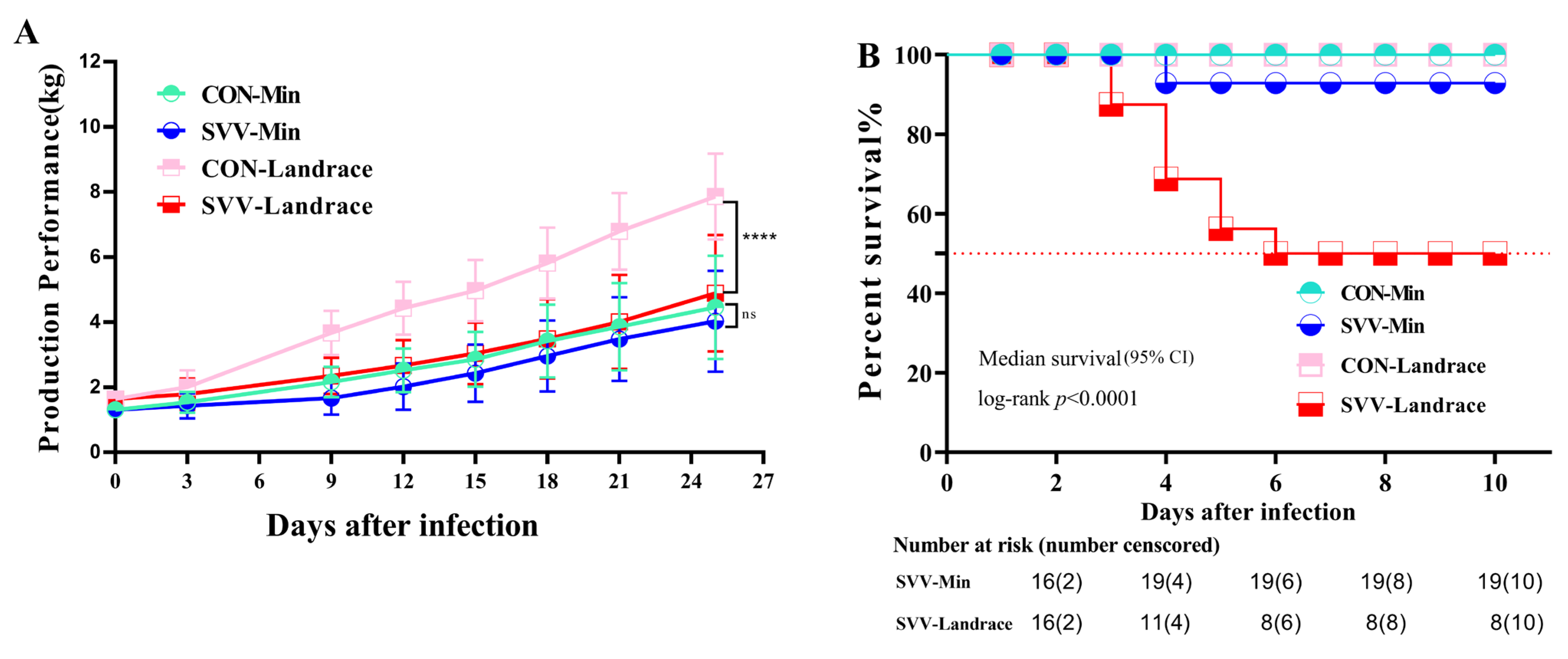

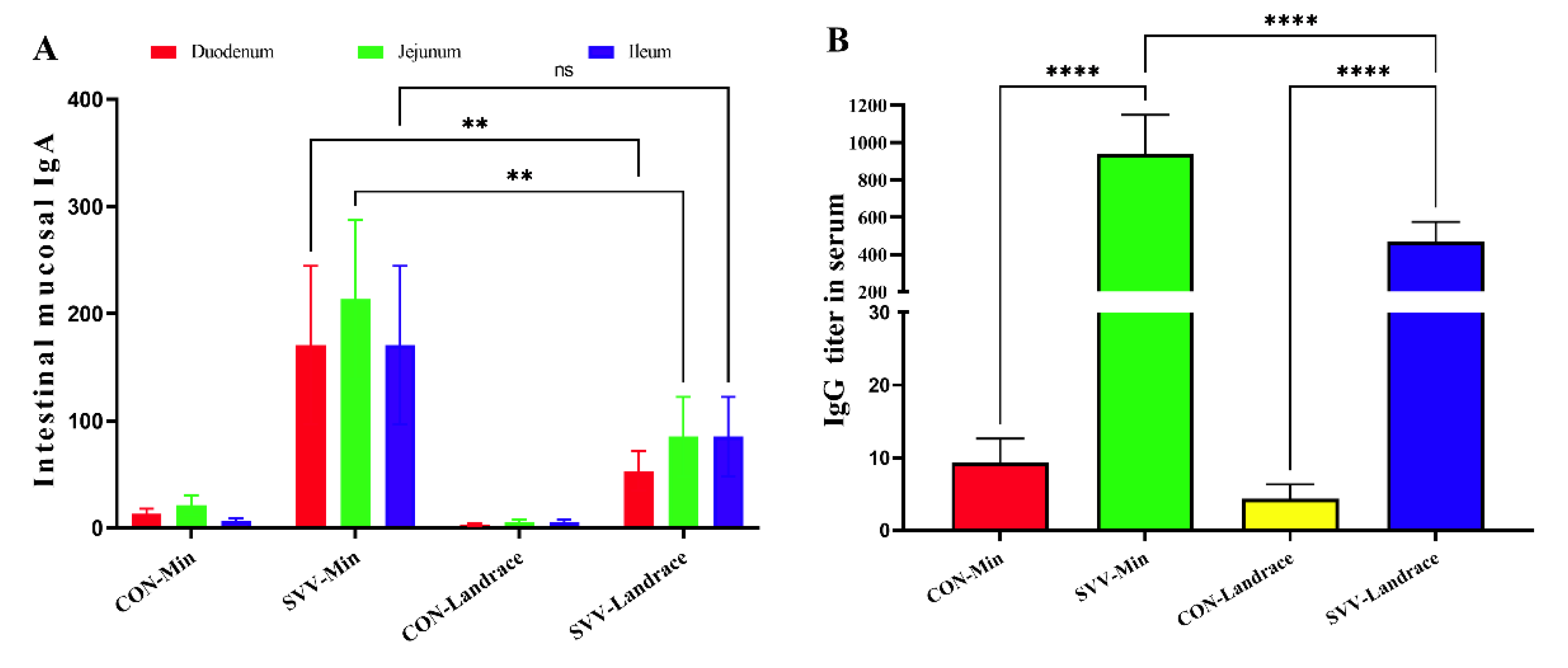
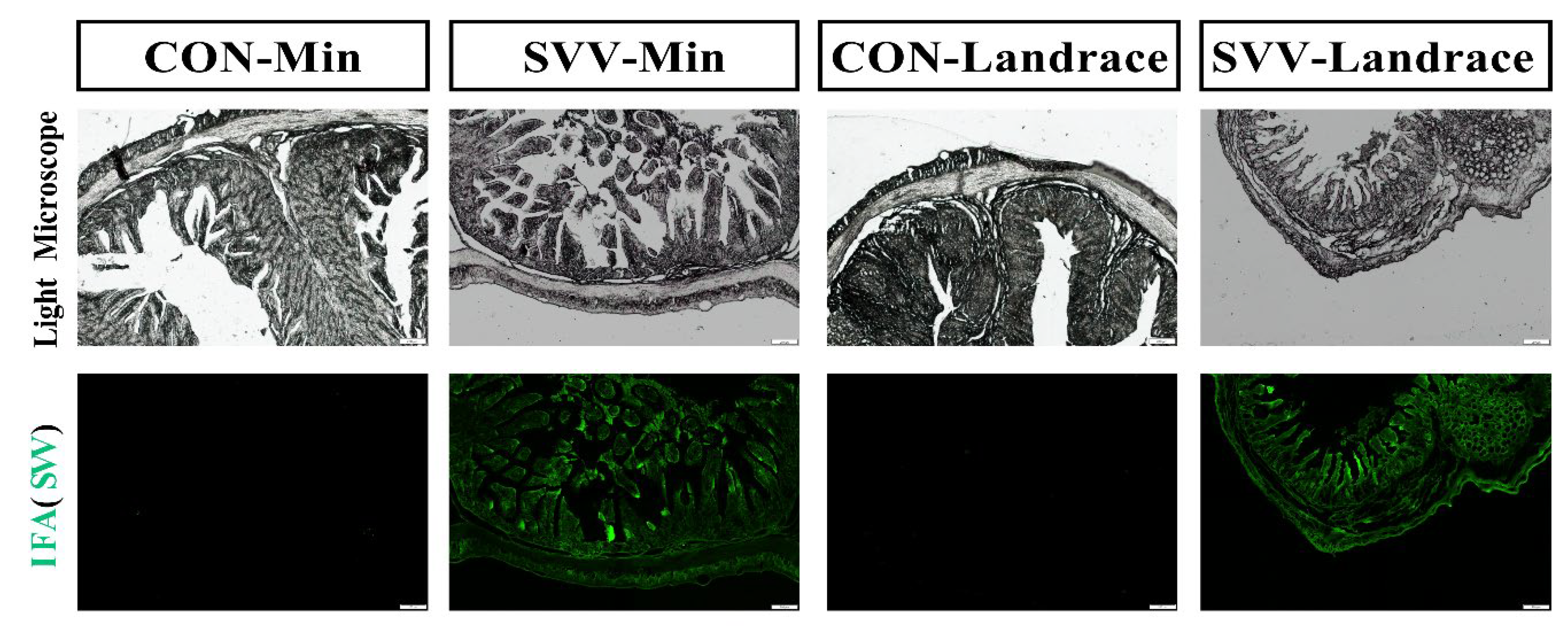

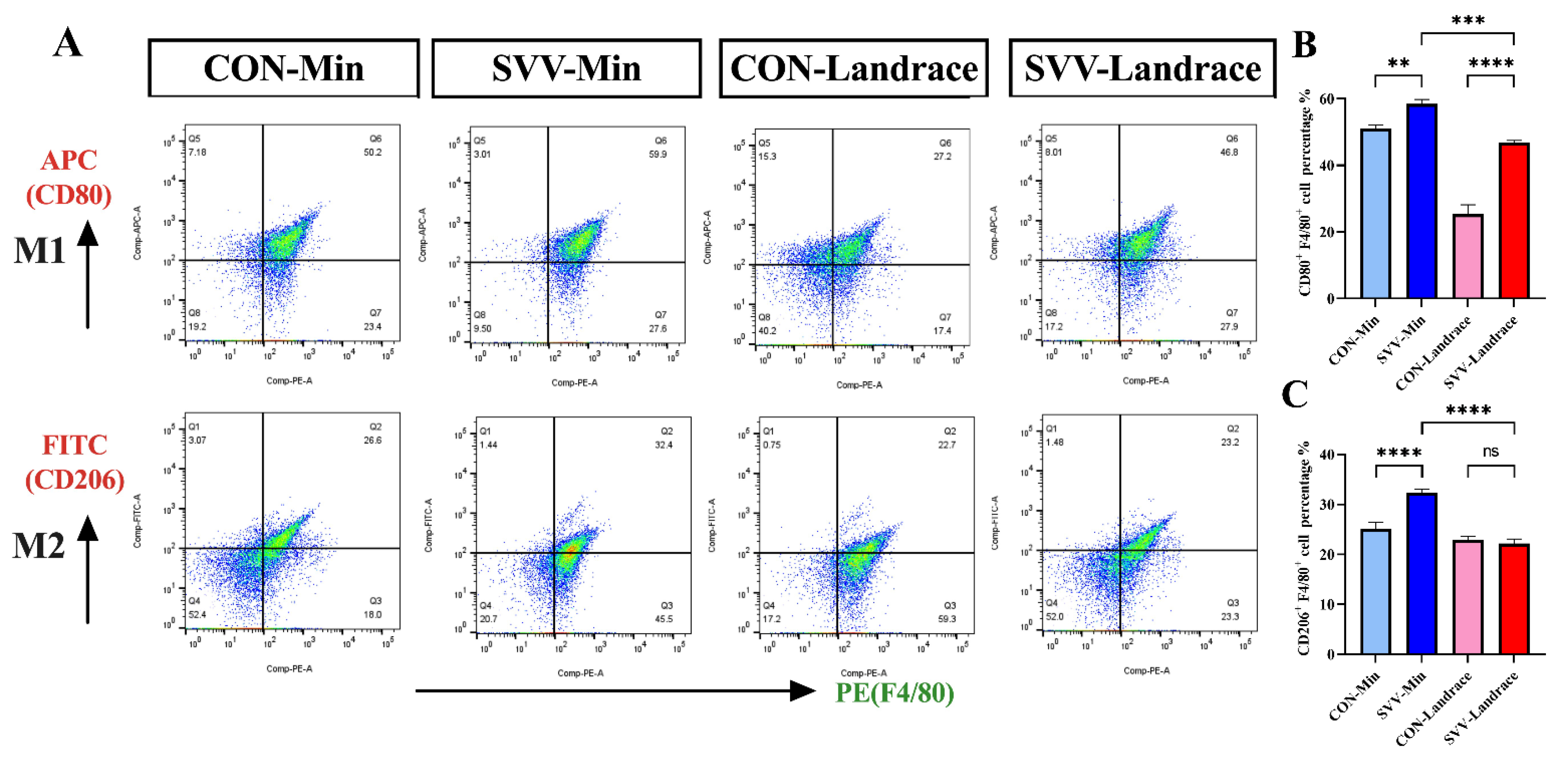
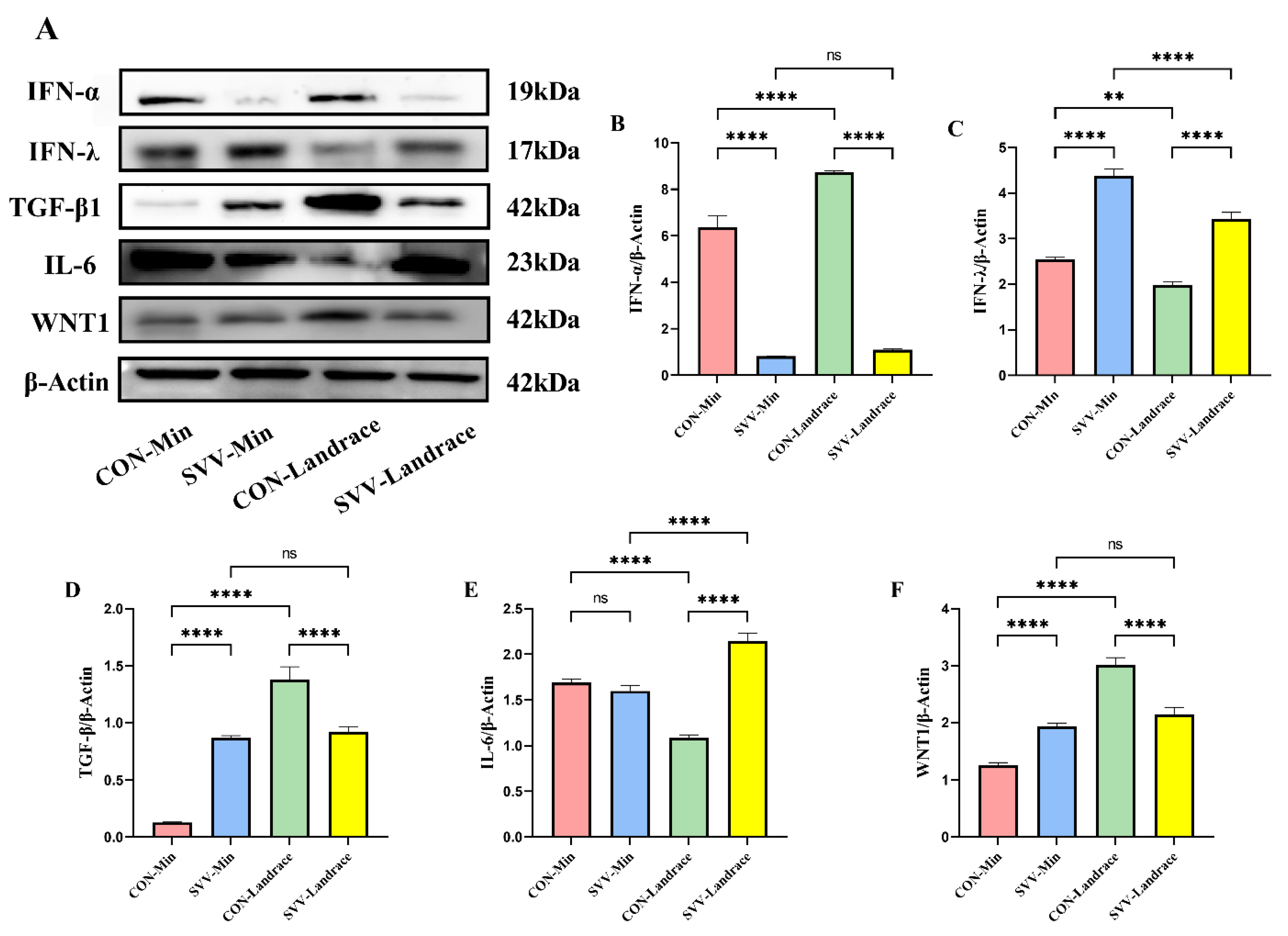
Disclaimer/Publisher’s Note: The statements, opinions and data contained in all publications are solely those of the individual author(s) and contributor(s) and not of MDPI and/or the editor(s). MDPI and/or the editor(s) disclaim responsibility for any injury to people or property resulting from any ideas, methods, instructions or products referred to in the content. |
© 2025 by the authors. Licensee MDPI, Basel, Switzerland. This article is an open access article distributed under the terms and conditions of the Creative Commons Attribution (CC BY) license (https://creativecommons.org/licenses/by/4.0/).
Share and Cite
Wang, W.; Han, F.; He, X.; Zhao, S.; Zou, Z.; Tian, M.; Chen, H.; Wu, S.; Sun, Y.; Jiang, Y.; et al. Breed Varieties of Pigs for Disease Resistance and Susceptibility to Seneca Valley Virus Infection. Int. J. Mol. Sci. 2025, 26, 8746. https://doi.org/10.3390/ijms26178746
Wang W, Han F, He X, Zhao S, Zou Z, Tian M, Chen H, Wu S, Sun Y, Jiang Y, et al. Breed Varieties of Pigs for Disease Resistance and Susceptibility to Seneca Valley Virus Infection. International Journal of Molecular Sciences. 2025; 26(17):8746. https://doi.org/10.3390/ijms26178746
Chicago/Turabian StyleWang, Wentao, Fengze Han, Xinmiao He, Shihan Zhao, Ziluo Zou, Ming Tian, Heshu Chen, Saihui Wu, Yan Sun, Yaokun Jiang, and et al. 2025. "Breed Varieties of Pigs for Disease Resistance and Susceptibility to Seneca Valley Virus Infection" International Journal of Molecular Sciences 26, no. 17: 8746. https://doi.org/10.3390/ijms26178746
APA StyleWang, W., Han, F., He, X., Zhao, S., Zou, Z., Tian, M., Chen, H., Wu, S., Sun, Y., Jiang, Y., Sun, M., Zhang, L., Yu, K., Wang, Y., Tian, Y., Jiang, X., & Liu, D. (2025). Breed Varieties of Pigs for Disease Resistance and Susceptibility to Seneca Valley Virus Infection. International Journal of Molecular Sciences, 26(17), 8746. https://doi.org/10.3390/ijms26178746






